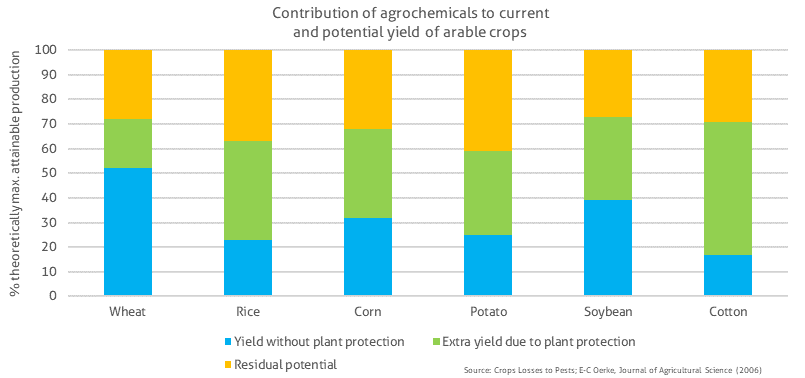Crop protection
Why crop protection?
The agricultural and horticultural industry faces a multitude of challenges:
- The growing world population: The world population is projected to increase by 250,000 every day and reach 9 billion by 2050, according to the United Nations. Those are 9 billion mouths to feed.
- Increased prosperity leads to changes in our diet and increased meat consumption.
- Crops are no longer used exclusively for food but are also proving their worth as fodder, fibers (e.g. cotton) and fuel (e.g. biodiesel, fuel from rapeseed oil).
- An increasing shortage of water and (farm) land.
The sole solution involves intensifying the agricultural and horticultural industry on a global scale.
1. A safe and adequate food supply for all
Agrochemicals protect crops against diseases, pests and weeds, thus ensuring a good harvest and plenty of food. Consumers expect the food they buy to be fresh, of high quality and free from disease, moulds and insect damage.
No easy feat, as crops throughout the world must face 80,000 types of mould, 30,000 types of weed, 3,000 nematodes and 10,000 insect herbivores. Agrochemicals protect the crops from these external factors, ensuring a good harvest. Even when using crop protection products, an average of 20 to 40% of the harvest is lost due to diseases and pests. These losses may occur in the field, during transport or during storage.
Extensive research into new agrochemicals and technologies is of vital importance if we want to protect crops and avoid plant resistance. In short, agrochemicals guarantee an adequate and safe food supply.
Over the course of the past 50 years life expectancy has risen by an average of 3 months per year in large parts of Europe. The contribution of agrochemicals in providing a safe and adequate food supply for all should not be underestimated.

2. Healthy, varied and affordable food for all
Developed countries too have experienced significant economic and social benefits through the use of agrochemicals, which have made fruits and vegetables affordable for all. Fruits and vegetables are not only essential parts of our diet, but also contribute to the prevention of heart and cardiovascular disease as well as certain types of cancer. And let’s not forget that agrochemicals have freed thousands of the arduous task of manual weeding. As agrochemicals contribute to a profitable agricultural industry, they also aid in maintaining agricultural communities.
3. Sustainable agriculture in developing countries
In Europe, agrochemicals have contributed to a healthy, adequate food supply for all. Developing countries, however, deal with daily food shortages and an unbalanced diet. According to the United Nations, the world population is projected to increase by 250,000 every day and reach 9 billion by 2050. Those are 9 billion mouths to feed. This increase in population is mostly noticeable in developing countries, where farming difficulties are far more common compared to these parts. Through the sustainable use of agrochemicals, developing countries will be able to increase their food production, making food affordable for a larger portion of its population.
4. Preserving tropical rainforests and biodiversity
An adequate food supply for an ever-growing world population: no small feat for the agricultural industry. Where will we find all this additional food? Planet Earth, after all, is finite… and so is good farming land. Moreover, there is the ever-present competition in using available land for agriculture, urbanization, recreation, …
If we want to feed the growing world population, two options remain: expand the agricultural area or increase existing farm lands’ yield.
Choosing the former, using more land as farm land, will result in a decreased availability for recreation, urbanization, etc. Nature reserves worldwide will be sacrificed to become farm land. If we truly wish to preserve our tropical rainforests and other habitats for some of the world’s unique fauna and flora, we must choose the latter, optimizing the yield per hectare of our current farm land. This option requires the use of agrochemicals.
